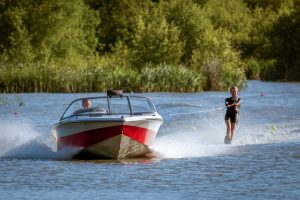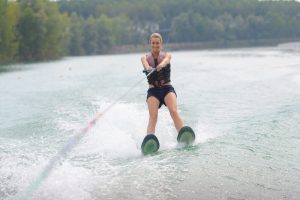Ever heard of water skiing? It’s a super fun water sport that’s been around for a while. But listen up, it can be risky if you’re not careful.
In this blog, we’re going to chat about what water skiing is, where it came from, and why it’s so popular today. Most importantly, we’ll share why safety matters and how to stay safe on the water. We’ll also bust some myths about water skiing. So buckle up, it’s time to dive in and learn how to make your water skiing adventures safe and sound!
The Need for Safety in Water Skiing
Water skiing is super fun, but it can be risky too. That’s why we always put safety first. Let’s dive into why safety is so important when we’re out on the water.
Risks Associated with Water Skiing
When we’re water skiing, we might get hurt. We could sprain our ankles or knees, or even collide with something in the water. In bad cases, we might fall and not be able to get back up, which is really dangerous. So, we always need to be careful.
Consequences of Not Being Safe
If we don’t follow safety rules, we could get really hurt, or even die. Plus, we could get in trouble with the law. If we cause an accident, we might have to pay a fine or get sued. And if we break any local water safety laws, we could get a penalty. So, it’s super important to always be safe.
Why Safety Practices are Important
We always say safety first! It’s important to know how to ski properly, use the right gear, keep your distance from others, watch the weather, and have a buddy with you. When we follow these rules, we can have a great time on the water and keep everyone safe.
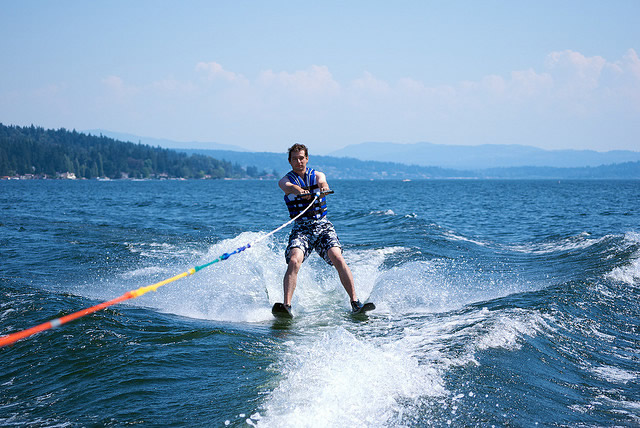
Recommended Water Skiing Safety Practices
Water skiing is an exhilarating sport, but it comes with its share of risks. Therefore, it is vital that we emphasize the importance of safety practices. Here are our top recommendations for safety practices to ensure an enjoyable and risk-free water skiing experience.
Adequate Training Before Taking on The Water
Before taking on the water, it’s essential to have proper training. Training not only imparts necessary water skiing skills but also educates on potential hazards and how to avoid them. It equips you with techniques to handle emergencies and reduce the risk of injuries. Training schools, certified instructors, and even online tutorials are good sources to acquire such training. We strongly advise not to take on water skiing without proper training.
Use of Proper and Well-Fitted Equipment
Proper equipment is vital in water skiing. This includes a good quality ski, a well-fitted life jacket, and a reliable tow rope. Each piece of equipment has a specific role to play. Skis provide the necessary buoyancy, control, and stability. A life jacket is a lifesaver in case of a fall. A tow rope connects the skier to the boat. It’s imperative that this equipment fits well to ensure optimal performance and safety. Poor fitting equipment can lead to accidents, so always double-check before hitting the water.
Keeping a Safe Distance from Other Water Bodies and Swimmers
Maintaining a safe distance from other water bodies and swimmers is crucial in preventing accidents. Collisions are one of the most common water skiing accidents. Hence, always ensure a clear path ahead and stay alert to changes in the surrounding environment.
Observing the Weather and Water Conditions
Weather and water conditions can significantly impact safety in water skiing. Always check the weather forecast before going out on the water. Avoid water skiing in stormy weather or when the water is too choppy. Be extra cautious in strong currents and winds. These conditions can make water skiing challenging and increase the risk of accidents.
Importance of Having a Spotter on The Boat
A spotter is someone who keeps an eye on the skier while the driver concentrates on navigating the boat. The spotter communicates with the skier and alerts the driver in case of any issues. They are essential in ensuring safety during water skiing. The spotter should be trained to understand different hand signals and respond quickly in emergency situations.
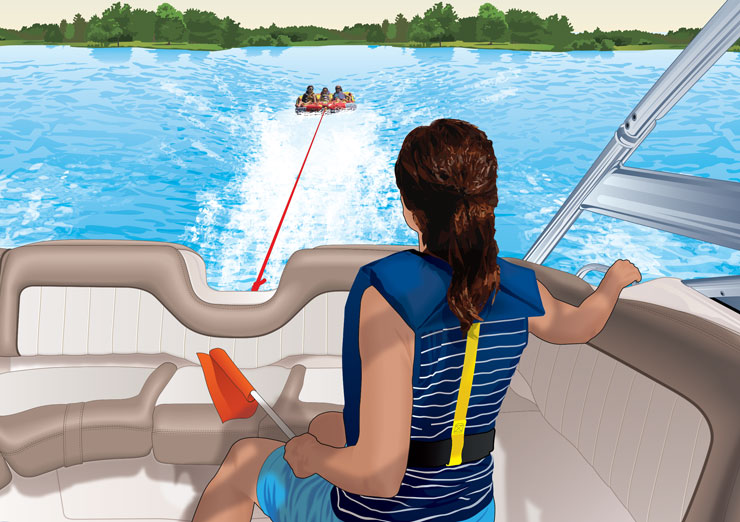
Water Skiing Safety Practice Quizzes
We think safety quizzes are super important for water skiing. They’re a fun way to make sure you’ve got all the safety stuff down pat. These quizzes help you figure out what you’re good at and what you need to work on.
Why Safety Quizzes are Cool
Safety quizzes are like a game that helps you remember all the safety rules of water skiing. They let you know if you’ve missed something so you can learn it better. In short, they make you a safety wizard for when you’re out on the water.
Practice Questions and Answers
Here are some example quiz questions:
Why do you need a lifejacket when water skiing?
Answer: It helps you float if you fall in the water.
What does a spotter do on the boat?
Answer: They keep an eye on the skier and talk to the driver.
Why should you stay away from other people and things in the water?
Answer: So you don’t crash into them.
Where to Find Quizzes and How to Use Them
You can find these quizzes on websites like Boat Ed, Water Ski World, and USA Water Ski. When you do these quizzes, pay attention to what you get wrong. Then you can learn more about those things. The aim is to be safe, not just to get all the answers right.
Always remember, being safe means having more fun. So, use these quizzes to become a water skiing safety champ!
Top Tips for Safe Water Skiing
- Know Your Local Water Skiing Rules
- Drink Water, Not Alcohol
- Always Wear a Lifejacket
- Learn and Use Hand Signals
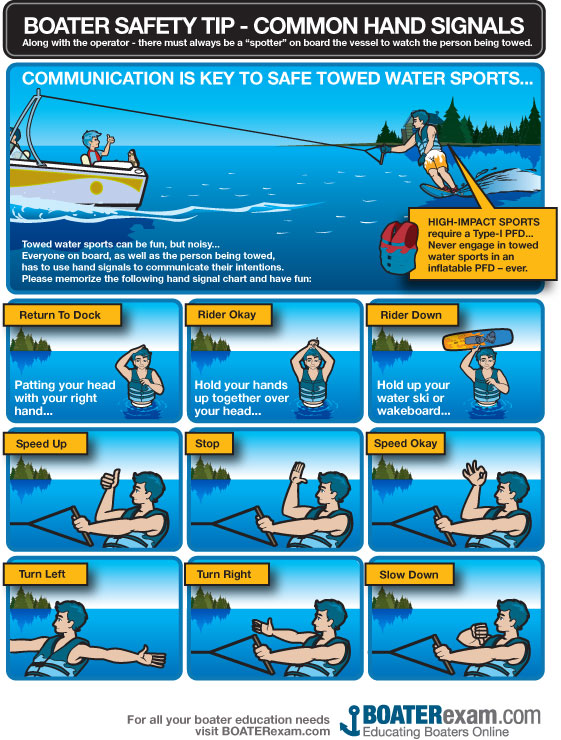
Source: Boaterexam.com
Common Misconceptions about Water Skiing Safety Practices
We often hear funny ideas about water skiing safety. Let’s clear things up and remind everyone why safety rules are so important.
Clearing Up Myths about Water Skiing Safety
Myth 1: Good swimmers don’t need life jackets. That’s not right! Everyone needs a life jacket when water skiing. If you fall, it keeps you floating and safe.
Myth 2: You don’t need to use hand signals. Wrong again! The boat is too noisy for shouting. Hand signals are the best way to talk to the boat driver.
Myth 3: You don’t need training to have fun. That’s a risky thought. Training makes you better at water skiing and helps you avoid getting hurt.
Reminding You of the Real Safety Rules
We’ve talked a lot about safety rules, and they’re all super important. They’re not just good ideas, they’re must-dos to keep you and everyone else safe.
Training is key. It gives you the skills to handle anything that comes your way. And always wear your equipment right, especially your life jacket. It could save your life!
Keep away from other swimmers and watch the weather. Having a friend on the boat to watch you is also a great idea. All of these rules help make water skiing safer and more fun.
Conclusion
We’ve journeyed through the world of water skiing safety practices.
Trail Tellers
We’ve explored the risks and rewards.
We’ve stressed the importance of training, equipment, and safety rules.
We’ve debunked myths and highlighted truths.
It’s clear that safety isn’t an option in water skiing, it’s a must. Ignoring it can lead to accidents or worse. But following proper safety practices can ensure a fun, exciting, and risk-free experience.
So, as we wrap up our discussion, we want to remind you of the key points. Get proper training. Use the right equipment. Follow the rules. Stay hydrated and sober. Always wear a lifejacket. Learn and use hand signals. And never forget to prioritize safety.
We hope that by sharing these insights, we’ve encouraged you to take safety seriously in water skiing. Remember, the goal is to have fun without risking your well-being. So, let’s go out there and enjoy water skiing, but let’s do it safely!
Read more: How to Hang Water Skis on Wall


